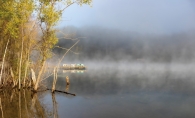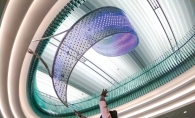On a 20-acre site of wooded land along the St. Croix River sits a small, historic cabin built around 1915. Set atop the river bluff with a porch overlooking the water, the cabin just north of Marine on St. Croix, Minn., has hosted 36 artists throughout the past 15 years—artists looking to find inspiration in nature. The St. Croix Watershed Research Station’s Artist at Pine Needles residency program provides two to three artists each summer a two- to four-week stay to focus on their craft, interact with scientists in the field and connect with the community.
The St. Croix Watershed Research Station is the environmental research department of the Science Museum of Minnesota and employs 15 staff members dedicated to the research of watershed issues in the St. Croix Valley and beyond. The Pine Needles program got its start in 2002 as a way to promote scientific understanding through art and to connect science to the community. Artists across mediums including writing, painting, sculpting, photography and printmaking have participated.The land and cabin were donated to the center in the 1990s by prominent local historian James Taylor Dunn. Watershed assistant director Sharon Mallman says many of the artists express gratitude for Dunn’s foresight in setting aside the land, which is 3 miles north of the station.
Landscape painter Joshua Cunningham spent two and a half weeks at Pine Needles last August and created about 20 paintings during his time there. He enjoyed the opportunity to unplug and tap into the cabin’s surroundings without any pressure or distraction. “Creativity can really bloom when it has no interruption and you can get lost in your dorky little imagination,” he says. “You get up, and the day becomes a continuation of the previous one.” Cunningham found inspiration in the sounds of frogs and crickets, the shapes clams carved into the sand at night, and the fog on the river.
He also had the chance to spend time in the field with senior scientist Mark Edlund, who studies aquatic biology. For Edlund, interacting with the artists offers the chance to exchange unique perspectives. “They can take things that I see every day under my microscope and think about them in new and creative ways—linking things as small as diatoms to romantic poetry,” Edlund says. “In return, I get to watch their minds explode with ideas as I expose them to worlds they never knew.”
In addition to connecting residents and researchers, the program fosters engagement with the local community. “Marine in particular has taken on the artist program as one of its own,” Mallman says. Artists are encouraged to create an outreach project as part of their stay, with past projects including talks at the Marine Community Library, poetry readings and a pottery workshop.
This year’s Pine Needles artists are poet Kim Roberts, photography and choral music collaborators Gary Noren and Marty Harding, illustrator Marly Beyer, and printmaker C.B. Sherlock. Each will be at the site at various times June through September.
As part of the residency, artists contribute a piece of original work inspired by their stay to the research station. These pieces line the station’s walls, covering much of the available space in the common areas and hallways, mere paces away from where scientists are busy working in the lab.
Applying for Pine Needles
Applications for the 2017 residency will be posted online during the first week of January and are accepted until the end February. Applications include a few personal statements along with examples of previous work.









